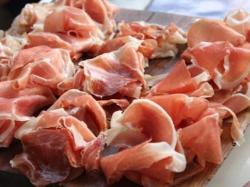La Quercia’s Herb Eckhouse Is America’s Prince Of Prosciutto
June 24, 2010 | 2 min to read

The history of salumi is as heavy and dense as a hanging leg of acorn-fed dry-cured prosciutto. For centuries in the glorious days of the Roman Empire, cured meats kept entire armies full when there was no means of refrigeration. A single pig was enough to feed a family of four through the winter and the spring. It might have been a functional means of nourishment, but it was also definitely delicious. Records of the production of prosciutto go back as far as 1559, in which a traditional law was in place that a pig could not be slaughtered any time other than just before our Christmas time. Many other stipulations, recipes and rules were in place along with these records. The Romans were serious about curing meat.
Today, other parts of the world are also very serious about protecting uniqueness and authenticity in their food and drink. The European Union’s DOP (Protected Designation of Origin Act) stipulates that “Champagne” can only come from Champagne, France. Various cheeses, for example Parmigiano-Reggiano, Feta, Gruyere, have earned the award of uniqueness in the form of a DOP trademark. But what if an artisan was making “Port Wine” in Vancouver that tasted just like its facsimile in Portugal? Can Japan make a superior product to Scotland’s Highland Scotch? (They actually did in 2008, earning best scotch of the year for their Yoichi 20 year bottle). What about a clearly un-Italian man in Iowa making a prosciutto that is preferred by acclaimed men like Mario Batali, Charlie Trotter, and Iron Chef Judge/Writer Jeffrey Steingarten?
Enter Herb and Kathy Eckhouse, owners (designers, builders and pioneers) of La Quercia (La Kwair-cha) prosciuttificio. Since February 2005 in Norwalk Iowa, they’ve been creating some seriously premium quality salumi. They are fine procurers of speck, pancetta, coppa, guanciale, lardo and prosciutto. Their prosciutto is dry cured without the use of nitrates or nitrites. Their pigs are bought from confinement and sub-therapeutic antibiotic-free farms where they are allowed to socialize and feed on a vegetarian, grain based diet.
To read the rest of the story, please go to: Good Food Revoltion.
